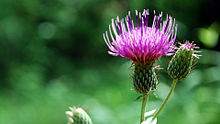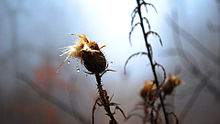| Cirsium discolor | |
|---|---|
.jpg) | |
| Scientific classification | |
| Kingdom: | Plantae |
| Clade: | Tracheophytes |
| Clade: | Angiosperms |
| Clade: | Eudicots |
| Clade: | Asterids |
| Order: | Asterales |
| Family: | Asteraceae |
| Genus: | Cirsium |
| Species: | C. discolor |
| Binomial name | |
| Cirsium discolor (Muhl. ex Willd.) Spreng. | |
| Synonyms[1] | |
| |
Cirsium discolor, the field thistle,[2] is a North American species of plants in the thistle tribe, within the sunflower family. It is native to thirty-three states in the United States as well four Canadian provinces.[3] It occurs across much of eastern and central Canada as well as eastern and central United States. It has been found from New Brunswick west to Saskatchewan and south as far as Texas and Georgia.[4]
Field thistle is a biennial or perennial herb up to 200 cm (78.5 in) tall, producing a large taproot. There is usually only one stem with numerous spiny leaves that are green on the upper side but white and woolly underneath. The plant's flower heads are large and showy and have the pale to medium value purplish magenta coloration (lilac, lavender, pinkish purple, purplish pink) that is especially attractive to butterflies.[5] The same color can be seen in the flowers of the genus Liatris, among many others. Heads have many disc florets but no ray florets. The species grows primarily in damp areas in forest openings, prairies, and disturbed sites.[6]
It is used as a component of some North American prairie and wildflower meadow restoration mixes that focus on the use of native species. Like most other thistles, it is a food plant for the caterpillars of the Painted Lady butterfly.[7] Most thistles produce a large quantity of nectar and pollen. The large flower heads make them attractive to large butterflies like migrating monarchs.[7] Bumblebees also make use of thistles, gathering the pollen.[7] Hummingbirds sometimes gather nectar from them.[7] This species is of similar size, height, and appearance to the Bull Thistle, but it is less spiny, has whitish leaf undersides, and, unlike Bull Thistle, often has quite pale flowers.[7] Many thistle species are monocarpic. This means that the plant will flower once and then die. Reproduction of this flower is dependent on seed distribution. This includes interaction with insects, habitat, and weather conditions.
References
- ^ The Plant List, Cirsium discolor (Muhl. ex Willd.) Spreng.
- ^ "Cirsium discolor". Natural Resources Conservation Service PLANTS Database. USDA. Retrieved 16 May 2016.
- ^ "Cirsium discolor (Muhl. ex Willd.) Spreng. field thistle". USDA Natural Resources Conservation Service. USDA. Retrieved 14 January 2018.
- ^ Biota of North America Program 2014 county distribution map Archived 2012-10-16 at the Wayback Machine
- ^ Roth, Sally (2002). Attracting Butterflies & Hummingbirds to Your Backyard. USA: Rodale Books. p. 28. ISBN 0875968880.
- ^ Flora of North America, Field thistle, chardon discolore, Cirsium discolor (Muhlenberg ex Willdenow) Sprengel
- ^ a b c d e Dr. John Hilty. "Pasture Thistle". Illinois Wildflowers. John Hilty. Retrieved 14 January 2018.
External links
- Lady Bird Johnson Wildflower Center, University of Texas
- Description from University of Southern Indiana
- Photo of herbarium specimen at Missouri Botanical Garden, collected in Missouri, showing leaves
- [1]

